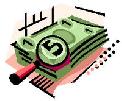
 |
|
| Financial Terms | |
| Bank line |
|
Information about financial, finance, business, accounting, payroll, inventory, investment, money, inventory control, stock trading, financial advisor, tax advisor, credit.
Main Page: payroll, accounting, finance, financial advisor, inventory control, credit, inventory, business, Also see related: property, mortgage, home financing, real estate, buy home, first time homebuyer, credit, homebuyer, condo, |
Definition of Bank line
Bank lineline of credit granted by a bank to a customer.
Related Terms:Demand line of creditA bank line of credit that enables a customer to borrow on a daily or on-demand basis. Documented discount notesCommercial paper backed by normal bank lines plus a letter of credit from a Revolving line of creditA bank line of credit on which the customer pays a commitment fee and can take Agency bankA form of organization commonly used by foreign banks to enter the U.S. market. An agency BAN (Bank anticipation notes)Notes issued by states and municipalities to obtain interim financing for Bank collection floatThe time that elapses between when a check is deposited into a bank account and when the funds are available to the depositor, during which period the bank is collecting payment from the payer's bank. Bank discount basisA convention used for quoting bids and offers for treasury bills in terms of annualized  Bank draftA draft addressed to a bank. Bank wireA computer message system linking major banks. It is used not for effecting payments, but as a Banker's acceptanceA short-term credit investment created by a non-financial firm and guaranteed by a Bank for International Settlements (BIS)An international bank headquartered in Basel, Switzerland, which BankruptcyState of being unable to pay debts. Thus, the ownership of the firm's assets is transferred from Bankruptcy cost viewThe argument that expected indirect and direct bankruptcy costs offset the other Bankruptcy riskThe risk that a firm will be unable to meet its debt obligations. Also referred to as default or insolvency risk. Bankruptcy viewThe argument that expected bankruptcy costs preclude firms from being financed entirely Capital market line (CML)The line defined by every combination of the risk-free asset and the market portfolio.  Cash flow time-lineline depicting the operating activities and cash flows for a firm over a particular period. Characteristic lineThe market model applied to a single security. The slope of the line is a security's beta. Clearing House Interbank Payments System (CHIPS)An international wire transfer system for high-value Consortium banksA merchant banking subsidiary set up by several banks that may or may not be of the Eligible bankers' acceptancesIn the BA market, an acceptance may be referred to as eligible because it is Euro lineslines of credit granted by banks (foreign or foreign branches of U.S. banks) for Eurocurrencies. EurobankA bank that regularly accepts foreign currency denominated deposits and makes foreign currency loans. Export-Import Bank (Ex-Im Bank)The U.S. federal government agency that extends trade credits to U.S. Federal Financing BankA federal institution that lends to a wide array of federal credit agencies funds it Federal Home Loan BanksThe institutions that regulate and lend to savings and loan associations. The Foreign banking marketThat portion of domestic bank loans supplied to foreigners for use abroad. International Bank for Reconstruction and Development - IBRD or World BankInternational bank for Reconstruction and Development makes loans at nearly conventional terms to countries for projects of high International Banking Facility (IBF)International banking Facility. A branch that an American bank Investment bankFinancial intermediaries who perform a variety of services, including aiding in the sale of Investment product line (IPML)The line of required returns for investment projects as a function of beta Legal bankruptcyA legal proceeding for liquidating or reorganizing a business. Line of credit An informal arrangement between a bank and a customer establishing a maximum loan Linear programmingTechnique for finding the maximum value of some equation subject to stated linear constraints. Linear regressionA statistical technique for fitting a straight line to a set of data points. Log-linear least-squares methodA statistical technique for fitting a curve to a set of data points. One of the Line of creditAn informal arrangement between a bank and a customer establishing a maximum loan Merchant bankA British term for a bank that specializes not in lending out its own funds, but in providing Money center banksbanks that raise most of their funds from the domestic and international money markets, relying less on depositors for funds. Mortgage pipelineThe period from the taking of applications from prospective mortgage borrowers to the Mortgage-pipeline riskThe risk associated with taking applications from prospective mortgage borrowers Old-line factoringFactoring arrangement that provides collection, insurance, and finance for accounts receivable. PIBOR (Paris Interbank Offer Rate)The deposit rate on interbank transactions in the Eurocurrency market Prepackaged bankruptcyA bankruptcy in which a debtor and its creditors pre-negotiate a plan or Security characteristic lineA plot of the excess return on a security over the risk-free rate as a function of Security market lineline representing the relationship between expected return and market risk. Simple linear regressionA regression analysis between only two variables, one dependent and the other explanatory. Simple linear trend modelAn extrapolative statistical model that asserts that earnings have a base level and Society for Worldwide Interbank Financial Telecommunications (SWIFT)A dedicated computer network to support funds transfer messages internationally between over 900 member banks worldwide. Straight line depreciationAn equal dollar amount of depreciation in each accounting period. Swingline facilitybank borrowing facility to provide finance while the firm replaces U.S. commercial paper Wholesale mortgage bankingThe purchasing of loans originated by others, with the servicing rights World BankA multilateral development finance agency created by the 1944 Bretton Woods, New STRAIGHT-LINE DEPRECIATIONA depreciation method that depreciates an asset the same amount for each year of its estimated BankMoney in a bank cheque account, the difference between receipts and payments. Bank overdraftMoney owed to the bank in a cheque account where payments exceed receipts. Line itemGeneric types of assets, liabilities, income or expense that are common to all businesses and Bank reconciliationThe process of taking the balances from the bank statement and the general ledger and making adjustments so that they agree. Straight-lineA method of depreciation. bottom lineA commonly used term that refers to the net income (profit) net income (also called the bottom line, earnings, net earnings, and netoperating earnings) straight-line depreciationThis depreciation method allocates a uniform Security Market LineA graph illustrating the equilibrium relationship between the line employeean employee who is directly responsible for linear programminga method of mathematical programming used to solve a problem that involves an objective function and multiple limiting factors or constraints long-term variable cost a cost that was traditionally viewed as a fixed cost Management Accounting Guidelines (MAGs)pronouncements of the Society of Management Accountants of product line marginsee segment margin red-line systeman inventory ordering system in which a red regression lineany line that goes through the means (or averages) of the set of observations for an independent variable and its dependent variables; mathematically, there is a line of “best fit,” which is the least squares regression line timelinerepresentation of the amounts and timing of all Bank reconciliationA comparison between the cash position recorded on a company’s bankruptcyThe reorganization or liquidation of a firm that cannot pay its debts. concentration bankingSystem whereby customers make payments to a regional collection center which transfers funds to line of creditAgreement by a bank that a company may borrow at any time up to an established limit. security market lineRelationship between expected return and beta. straight-line depreciationConstant depreciation for each year of the asset’s accounting life. Central BankA public agency responsible for regulating and controlling an economy's monetary and financial institutions. It is the sole money-issuing authority. Commercial BankA privately owned, profit-seeking firm that accepts deposits and makes loans. Federal Reserve BanksThe twelve district banks in the Federal Reserve System. 45-Degree LineA line representing equilibrium in the goods and services market, on a diagram with aggregate demand on the vertical axis and aggregate supply on the horizontal axis. Fractional Reserve BankingA banking system in which banks hold only a fraction of their outstanding deposits in cash or on deposit with the central bank. Investment BankerMiddleman between a corporation issuing new securities and the public. The middleman buys the securities issue outright and then resells it to customers. Also called an underwriter. World BankThe International bank for Reconstruction and Development, an international organization that provides long-term loans to developing countries to improve their infrastructure. Other-than-Temporary Decline in Market ValueThe standard used to describe a decline in market value that is not expected to recover. The use of the other-than-temporary description as Bankers AcceptancesA bill of exchange, or draft, drawn by the borrower for payment on a specified date, and accepted by a chartered bank. Upon acceptance, the bill becomes, in effect, a postdated certified cheque. Formalized Line of CreditA contractual commitment to make loans to a particular borrower up to a specified maximum during a specified period, usually one year. Line of CreditAn agreement negotiated between a borrower and a lender which establishes the maximum amount against which a borrower may draw. The agreement also sets out other conditions, such as how and when money borrowed against the line of credit is to be repaid. Merchant BankA financial institution that engages in investment banking functions, such as advising clients in mergers and acquisitions, underwriting securities and taking debt or equity positions. Operating Line of CreditA bank's commitment to make loans to a particular borrower up to a specified maximum for a specified period, usually one year. ABM (automated banking machine)A bank machine, sometimes referred to as an automated teller machine (ATM). bank draftA guaranteed form of payment which is issued in amounts over $5,000. line of creditA revolving source of credit with a pre-established limit. You access the funds only as you need them, and any amount that you pay back becomes accessible to you again. Unlike a personal loan, a line of credit permits you to write cheques and make bank machine withdrawals, and requires you to pay interest only on the funds that you actually use. online bill paymentThe electronic payment of a bill via the Internet. The specified amount of the bill is electronically debited from your account. personal line of credit (PLC)A revolving source of credit with a pre-established limit. You access the funds only as you need them, and any amount that you pay back becomes accessible to you again. Unlike a personal loan, a PLC permits you to write cheques and make bank machine withdrawals, and requires you to pay interest only on the funds that you actually use. secured loan or line of creditA lump sum of funds (loan), or a revolving source of credit with a pre-established limit (line of credit), for which the customer must provide collateral. Personal Line of credit (Credit Insurance)A bank's commitment to make loans to a borrower up to a specified maximum during a specific period, usually one year. Rate riskIn banking, the risk that profits may decline or losses occur because a rise in interest rates forces up Transaction loanA loan extended by a bank for a specific purpose. In contrast, lines of credit and revolving Credit CrunchA decline in the ability or willingness of banks to lend. Related to : financial, finance, business, accounting, payroll, inventory, investment, money, inventory control, stock trading, financial advisor, tax advisor, credit. |